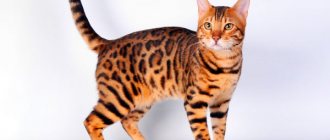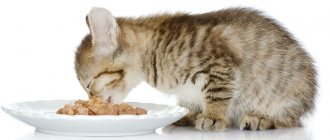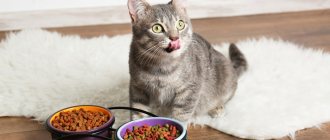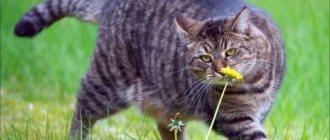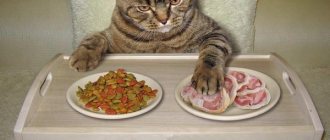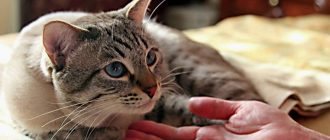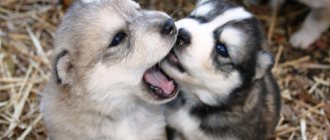Best food for Persian cats
- Orijen Cat 6 Fresh Fish 2014 (Canada) – holistic food;
- Golden Eagle Holistic Adult Cat 32/21 (USA) – holistic food;
- Bosch Sanabelle Hair & Skin for Cats (Germany) – super premium food;
- Purina Pro Plan Delicate (France, Italy) – super-premium;
- Royal Canin Persian (France, USA) – premium class.
Orijen Cat 6 Fresh Fish 2014
Canadian-made grain-free food contains 6 varieties of fresh fish: herring, salmon, pollock, flounder, pike, white fish. Fish makes up 80% of all food. Protein content – 42%, fat – 20%. The source of carbohydrates is lentils. Fats – fish oil, herring oil, rapeseed oil. Fruits and vegetables: apples, carrots, peas, spinach, alfalfa, pumpkin and cranberries. Enriched with a vitamin-mineral complex of 38 elements. Flat granules of dark brown color. Does not contain flavorings or preservatives.
Plus feed: economical consumption.
Disadvantage of the food: high price.
Price:
- 340 g – 429 rubles (214 UAH);
- 1.8 kg – 1882 rubles (940 UAH);
- 5.4 kg – 3999 rubles (2000 UAH).
Buy on Zoopassage.
Golden Eagle Holistic Adult Cat 32/21
A high-quality American-made product with protein (32%) and fat (21%) content adapted to the needs of cats.
Protein composition: chicken meal, salmon meal, egg. Carbohydrates: brown rice, potatoes, rice, beet pulp, rolled oats, flaxseed. Fruit and vegetable composition: apples, carrots, peas, tomato pulp, alfalfa, parsley and cranberries.
Contains a complete vitamin and mineral complex. The food recipe was developed taking into account the recommendations of geneticists, veterinarians and nutritionists. Can be given to cats during lactation.
Plus the food: it contains only fresh products.
Disadvantage of food: tomatoes – possible presence of pesticides.
Prices:
- 400 g – 439 rubles (220 UAH);
- 2 kg – 1396 rubles (698 UAH);
- 4 kg – 2622 rubles (1310 UAH).
Buy on the website happy-pet.
Bosch Sanabelle Hair & Skin for Cats
Dry food for adult cats from the German manufacturer Bosch with a high protein (32%) and fat (19%) content.
Main ingredients: liver, poultry, salmon meal, meat meal, greaves, rice flour, beet pulp, flaxseed. Sources of fat: fish oil and animal fat. Blueberries and cranberry powder are used as natural antioxidants. The source of inulin is chicory root. The food has a beneficial effect on the digestive system. The formula is designed specifically for long-haired cats.
Plus food: a balanced formula for healthy skin and coat.
Disadvantage of the food: it contains sorghum - a difficult to digest product.
Price:
- 2 kg – 2084 rubles (940 UAH);
- 10 kg – 5734 rubles (2867 UAH).
Buy on Dogeat.
Purina Pro Plan Delicate
Italian-made food for cats with sensitive digestion and picky eaters. Protein content – 40%, fat – 18%.
Ingredients: turkey, rice, corn, animal fat, powdered eggs, fish oil, peas, yeast. Vitamins and minerals: A, D3, E, C, copper, iodine, iron, selenium, zinc and manganese. Highly nutritious food, well digestible by cats. The granules are not large. Suitable for nursing cats.
Plus feed: high protein content.
Disadvantage of the food: it contains cellulose - a cheap filler.
Price:
- 400 g – 275 rubles (137 UAH);
- 1.5 kg – 918 rubles (459 UAH);
- 3 kg – 1725 rubles (862 UAH);
- 10 kg – 5196 rubles (2598 UAH).
Buy on Zoopassage.
Royal Canin Persian
The food is specially developed for adult cats and Persian cats. The formula of the food contains substances necessary for the healthy maintenance of thick and long hair. Prevents the development of gastrointestinal diseases.
Ingredients: dried poultry meat, rice, animal fats, corn, chicory root extract, borage oil, plantain seeds, marigold extract. Vitamins and minerals: A, B3, iron, selenium, manganese, copper, iodine.
Plus food: special food for Persian cats.
Disadvantage of the food: contains corn - allergic reactions are possible.
Prices:
- 400 g – 279 rubles (140 UAH);
- 2 kg – 1195 rubles (597 UAH);
- 4 kg – 2240 rubles (1120 UAH);
- 10 kg – 5459 rubles (2730 UAH).
Buy on Zoopassage.
It is important to follow the feeding standards, which depend on the cat’s weight - indicated on the food packaging. Exceeding the norm can lead to obesity and cardiovascular diseases.
There is no need to give vitamins to cats - they are included in the food. Excess vitamins lead to hypervitaminosis!
Is there a danger in high ash content?
You will be surprised, but according to industry standards, the manufacturer generally has the right not to write the ash content on the packaging, since this component of the guaranteed analysis in itself does not affect anything. However, individual microelements that are part of the total ash content may have an indirect effect on the occurrence of urolithiasis (with reservations, of course). Let's go through them in more detail.
Magnesium
Magnesium is an essential trace element that has a huge impact on the muscle and nervous activity of the cat’s body. In excess amounts, magnesium not only participates in the formation of struvite, but also contributes to the alkalization of urine.
However, not all so simple. Studies have shown that if the optimal urine pH balance is maintained, that is, for cats this is a slightly acidic reaction ({amp}lt;7.0), then even a serious excess of magnesium does not promote the growth of struvite. Moreover, the threshold for excess magnesium, which most likely contributes to the occurrence of urolithiasis, is 0.35% or 3500 mg/kg (with a norm of 1000 mg/kg) - you can sleep peacefully, not a single food in the world and not a single raw material contains such a huge amount of magnesium!
Calcium and phosphorus
Both calcium and phosphorus are equally important for the cat’s body, but there is a nuance - phosphorus promotes the removal of calcium from the body and is precisely the substance that leads to the formation of struvite (they are also called tripelphosphates).
- The FEDIAF organization has established the minimum acceptable ratio of Ca to P in cat food, it is 1:1.
- As for the permissible maximum, for kittens it is 1.5:1, and for adult cats 2:1.
We invite you to read: What is the correct name for a donkey and a donkey and what is the difference
Even if the manufacturer has not indicated the ratio, you can very simply calculate it yourself - the amount of calcium must be divided by the amount of phosphorus.
What to feed a Persian kitten
Until the kitten is 2 months old, its main food is mother's milk. It contains all the necessary nutrients, minerals and vitamins.
The baby can try the first complementary foods as early as 1 month, but veterinarians advise not to rush into this. The Persian's delicate stomach should become stronger and the gastrointestinal tract should be fully formed. At two months of age, the kitten is ready to try adult food.
The first thing you should introduce him to is porridge with milk diluted with water. There is no need to salt or sweeten them. A little later, around 3 months, you can give the kitten frozen raw meat. Be sure to grind it well. At the same age, you can give vegetable puree from boiled vegetables. You need to give new food a little at a time - half a teaspoon will be enough. Little Persians eat often - 5-6 times a day.
A six-month-old kitten is fed less often - 3-4 times a day. 6 months is the age when you can start feeding Persian kittens food for adult cats. We will talk about ready-made industrial feed. You can feed the food that his mother eats, but it is better to choose special lines of food designed for kittens.
Ready-made food for Persian kittens
- GO! NATURAL Holistic – holistic food for kittens and cats with sensitive digestion;
- Perfect Fit “Junior” – canned food for kittens (super-premium);
- Wahre Liebe “Junge” – premium dry food;
- Royal Canin Kitten – dry food for kittens up to 12 months (premium class);
- Royal Canin Persian Kitten – dry food for Persian kittens (premium class).
You can completely switch to feeding with ready-made food at 12 months. It is important to ensure that your kitten always has fresh water. There should be plenty of water and it should be freely available.
Read more about kitten nutrition here.
Compound
To analyze the composition, we compare the German and Russian versions. The composition of the food is by no means laconic - about 25 ingredients.
On the front side of the packages it is stated that the content of meat components is 70%, and of course we will check this. The first two ingredients are of animal origin, which is good news. For the other components, I will indicate in parentheses their position relative to the beginning of the composition to make it easier to analyze.
- Feed with bull meat: fresh chicken meat (37.5%), fresh Simmental bull meat (15%), poultry protein (7.5% dehydrated) (4th place), hydrolyzed protein (4.5%) ( 7th place), fresh liver (3.7%) (9th place), liver (2.5%, dehydrated) (10th place).
- Roe deer feed: fresh chicken (37.5%), fresh roe deer (15%), poultry protein (7%, dehydrated) (4th place), hydrolyzed protein (4.5%) (5th place), fresh liver (3.7%) (8th place), liver (2.5%, dehydrated) (9th place).
- Salmon food: fresh chicken (37.5%), fresh salmon (18%), hydrolyzed protein (4.5%) (5th place), poultry protein (4%, dehydrated) (6th place), fresh liver (3.7%) (8th place), liver (2.5%, dehydrated) (10th place).
Without further ado, we look at the German/English composition and immediately see surprises. The fact is that regarding the first two ingredients we are not talking about meat, that is, muscle tissue, most likely these are whole fresh carcasses, without giblets, legs, heads, but with skin, small bones and cartilage. In English, these ingredients sound like fresh chicken, fresh simmental beef, fresh roe deer, fresh salmon - do you see the word meat here? Me not. Carcasses are not bad, we could do without embellishing the composition, comrades Russian translators!
It should be noted that the meat of Simmental bulls and roe deer was added more to attract the attention of the buyer and in order to give the food a certain touch of delicacy - these ingredients are only 15% raw, and only God knows how much of it will remain after baking the croquettes. The main meat component of the food is chicken.
Next we have a whole series of questions.
- Poultry protein does not have a clear raw material. This allows us to assume that the raw material for a given ingredient varies depending on what the supplier provides. And this deprives us of the opportunity to evaluate its quality and nutritional value. By the way, in the English and German versions the word “meat” is also absent from this component.
- The same can be said in relation to fresh liver and dehydrated liver: whose liver is unknown, as is its quality.
- And the completely mysterious hydrolyzed protein completely threw me into a stupor. What protein - animal or plant? In English it says hydrolysed protein - that is, some kind of hydrolyzate, it is unknown what it was boiled from, maybe even from old shoes or animals that died a natural death - who knows? Although I indicated it in the composition of meat products, I will not take it into account when calculating the mass fraction of meat products.
So, according to the calculations of meat ingredients:
- in feed with bull meat – 66.2%;
- in roe deer feed – 65.7%;
- in food with salmon – 65.7%.
With an unknown hydrolyzate it would have been exactly 70%, but since its origin in the composition was not indicated, we will not make any concessions to the manufacturer. The difference is certainly not critical, and 4-4.5% can be forgiven, but what is depressing is not so much the quantity of meat components as their quality.
Fats in Bosch Sanabelle DELICIOUS food are presented as:
- sunflower oil (0.5%);
- salmon fat (0.5%);
- animal fat – added only to roe deer feed.
Sunflower oil is a frequent guest in animal food when the manufacturer wants to save on high-quality animal fats - vegetable fats are less beneficial for cats than animal fats. In this case, the extraction method is unknown; most often, cheaper, hot-pressed oil is used in feed. And this deprives vegetable fat of the lion’s share of nutrients and contributes to faster rancidity. The degree of oil purification is also questionable.
Salmon oil is better for cats because it is enriched with valuable Omega 3 fatty acids, but there is no indication of how to preserve the oil. And the amount of 0.5% seems frivolous to me; one can hardly expect real benefits from this ingredient.
Animal fat is a collective component - after all, we do not know either the primary raw material, or the degree of purification, or the preservation method. Most often, low-quality recycled fats that are considered unsuitable for human consumption are combined under this general name.
Carbohydrates
- Feed with steer meat: potatoes (8%, dehydrated) (3rd place), peas (dehydrated) (5th place), sunflower protein (4%) (7th place), chickpeas (4%, dehydrated) (8th place), potato protein (12th place).
- Roe deer feed: potatoes (14%, dehydrated) (3rd place), peas (dehydrated) (6th place), sunflower protein (4%) (7th place), potato protein (11th place).
- Salmon food: sweet potato (8%, dehydrated) (3rd place), potato (dehydrated) (4th place), sunflower protein (4%) (7th place), peas (dehydrated) (9th place), potato protein (12th place) ).
So, what first caught my eye - hello, split system! This refers to the dirty trick of dividing a component into several components in order to move meat components higher on the list. We are talking about dehydrated potatoes, which are already in third place in the composition, and potato protein, which hangs out somewhere closer to the end of the list.
Let's talk in more detail about carbohydrates in Bosch Sanabelle DELICIOUS food
We invite you to familiarize yourself with: The common beaver is a hardworking builder. Description and photo of the common beaver
Dehydrated potatoes and potato protein. Potatoes are a lesser evil compared to cereals, but essentially they are just an inexpensive filler and source of complex carbohydrates. Dried potatoes are better than flour, but less healthy than whole ones. Potato protein is a low quality food ingredient and is not complete for cats.
Sweet potato is a fairly healthy vegetable and a source of carbohydrates that contains many vitamins and has the ability to regulate blood sugar levels.
Dehydrated peas. We are talking about dehydrated pea grains. It has a low glycemic index and is more preferable in cat food. Contains a large amount of vegetable protein, which is not complete for carnivorous animals.
Dehydrated chickpeas - or lamb peas - are similar in properties to regular peas, contain a large amount of vegetable protein, beneficial microelements and do not cause spikes in blood sugar. The product is very filling and high-calorie; in small quantities it is more beneficial than harmful.
Sunflower protein. It’s funny that on the official website the manufacturer called the combination of sunflower oil and sunflower protein an “extra dose of sun,” because cats don’t need this plant at all. For a predator, animal proteins and fats are much more important, and their plant analogues are in any case inferior to them. So sunflower protein is just a cheaper substitute for animal protein.
Supplements
There are quite a lot of additives in the feed, but none of them indicate their mass fraction in percentage, so we will dwell in more detail on only a few.
Plantain seeds (psyllium) are rich in soluble fiber, which helps normalize digestion (but can also play a cruel joke - gastrointestinal upset in some animals), but the exact amount of psyllium in food is not known.
Green-lipped clam extract sounds scary, but in fact it's just regular green mussels. Mussel extract is very rich in glycosaminoglycans, which are building materials for joints and cartilage tissue. But the exact amount, and therefore the benefits of this extract, are not known.
Brewer's yeast (dehydrated) is a source of protein and B vitamins.
Cellulose is a cheap, rough litter that provides no benefit to cats.
Dehydrated berries (cranberries, blueberries) – dried berries are less healthy than fresh ones. However, since their exact mass fraction of berries in the feed is not known, no specific benefit should be expected.
Herbs (marigold extract, yucca, chicory powder, fennel, catnip, watercress) – the herbs in the feed are dehydrated, some of them help maintain healthy gastrointestinal microflora, others have antioxidant, anti-inflammatory, and multi-healing effects. However, the number of herbs is unknown, as is whether they will provide any real health benefits to the cat.
The sources of animal protein in Pronature Original food are dehydrated meat products. For all five types, the ingredient “chicken flour” is in first place. However, in the composition in English this component is designated as chicken meal, that is, chicken flour, which allows us to conclude that the translation is inaccurate, which was most likely made to embellish the composition.
Dried egg - in English it sounds like dried egg product. It is found only in kitten food in 6th place in the composition. This is a waste product from egg production and may include undeveloped eggs and/or shells. The Russian translation is again inaccurate and is intended to embellish the real qualities of the ingredient, since the nutritional value of the egg product can vary from case to case.
Natural flavoring – found in all foods in the line. Most likely we are talking about digesta - a concentrate obtained through high-temperature processing and the use of acids from animal raw materials. This ingredient does not provide any nutritional value; it only makes the food more aromatic and tasty for cats. It does not inspire confidence, since primary raw materials can vary in quality and nutritional value.
Salmon meat meal - found in the food “Meat Fiesta” (No. 10 on the list) and “Sea Delight” (No. 7). In English, the name of the component sounds like “salmon meal.” Not the worst component, although it is considered less valuable than raw or fresh salmon, since it was subjected to deep processing even before being added to the feed.
Nutrition for illnesses
Let's talk about what food to feed a Persian cat that has health problems. Persians are genetically predisposed to diseases of the urinary system: urolithiasis, chronic renal failure, etc. Especially for such cases, leading manufacturers of cat products produce lines of medicinal food.
Medicinal brands for the Persian cat:
- Royal Canin Renal – chronic renal failure, prevention of relapse of urolithiasis;
- Pro Plan Veterinary Diets – kidney disease;
- Hill's “K/D” – maintaining kidney function;
- Beaphar "Nieren Ente" – kidney failure;
- Royal Canin Urinary Metal Feline – diseases of the urinary tract.
It is unacceptable to put your cat on a therapeutic diet on your own; it must be prescribed by a veterinarian.
What is a trichobezoar
You can, of course, shave your cat like a poodle, choose food with a high amount of fiber, or set up a mini home garden or sprout grass for your pet. But today we will tell you about another way to combat trichobezoars - this is malt paste.
Malt in English means “malt”. Malt is grains (usually barley or other feed grains) that undergo fermentation during germination and release a substance that can break down starch into simple sugars - diastase. When yeast and sugar are added, they turn into alcohol. This property makes malt an indispensable product for breweries and wine production.
- However, in malt paste, malt is just a source of fiber, a sweetener and a flavor enhancer.
- Malt paste also contains vegetable oils and sometimes pre- and/or probiotics.
We suggest you read: Diseases and injuries of the tail in cats
Cats really like the taste of malt extract. Plant coarse fibers stimulate intestinal motility, helping to move hairballs towards the “exit”. Thus, the ingested hair leaves the cat’s body naturally – easily and painlessly.
With regular use of malt paste, pets:
- stool is normalized;
- vomiting passes;
- appetite improves.
Some owners think that malt paste stimulates hair vomiting in pets - this is not true!
Industrial feed
Let's start with the fact that high-quality food can only be bought in specialized pet stores. Economy-class food from supermarkets such as Wiskas, Kiticat, Tomcat and others is not suitable for feeding Persian cats; their low cost is explained by the presence of cattle bones and skins.
When choosing food in a store, you should carefully study the composition on the packaging. Below is the optimal ratio of substances in wet and dry industrial feeds: about 30-35% is a meat (protein) product, 20-25% is dietary fiber, 15-25% is natural fillers (milk or egg white), 7-10% consists of by-products (kidneys, liver, lungs, bone meal).
It is also necessary to contain 1-2% natural oils and mineral components (calcium, phosphorus, copper, iron, etc.), as well as vitamin complexes for animals.
When choosing food, do not trust advertisements with happy pets. It is better to carefully check the composition for the presence of dyes, flavors, flavor enhancers and preservatives. If such information is not provided, do not purchase this product under any circumstances, it may cost your cat’s health.
The food should be homogeneous, with a non-repulsive odor, and approximately the same color - colored pads indicate the presence of dyes in the food. The packaging should indicate the consumption rate depending on the weight and age of the cat; they must be adhered to so as not to harm the pet.
At the same time, you cannot additionally give vitamins of groups A, B, C, D, because they are already contained in the treat in the prescribed quantity, in order to avoid hypervitaminosis.
Provide the animal with clean drinking water near the place where it eats! Moreover, the water is not from the tap, preferably filtered or boiled.
What Persians can't do
Just like some other cat breeds, Persian cats cannot eat certain foods that are very familiar to people, but harmful to animals. It is strictly forbidden to feed Persians the following foods:
- fatty meats, especially pork, lamb, fatty parts of poultry – take a long time to digest and make it difficult for the liver;
- boiled-smoked products - sausages, sausages, smoked hams, etc.;
- eggplants contain substances that are toxic to animals;
- any spices and additives, including salt, mayonnaise, ketchup;
- tubular bones - can cause injuries to the digestive tract, get stuck in the throat or completely block the intestinal patency;
- onions and garlic - irritate the mucous membranes and cause fermentation;
- liver, boiled or raw;
- fatty sour cream and cream - cause digestive problems;
- sweets are also poisonous to animals.
It is also recommended to limit the amount of dairy products. Abuse of them can cause indigestion and bloating. Although fish is a tasty delicacy for animals, in excessive quantities it can harm the animal’s kidneys. To prevent possible complications, its use is limited to twice a week.
If the owner takes care of a healthy and balanced diet for the Persian cat, he will be able to enjoy his friendly company for many years. The thick and lush fur of representatives of the breed will please the eye only if the cat’s body has enough minerals and essential vitamins.
The correct nutrition menu for a Persian – ready-made food or natural products?
The food of a Persian cat should saturate the pet’s body with all useful components. These can be natural products (meat, grains, vegetables and fruits) or ready-made food with a balanced composition. It is recommended to pre-boil natural products (meat, fish, offal, grains); vegetables can be given both raw and boiled.
What food is best to feed your Persian? It is advisable to choose diets created specifically for this breed or group of long-haired cats. They contain phytomins - plant complexes that promote the removal of hair from the gastrointestinal tract. A separate cleaning product is malt paste; it cleans and improves the intestinal microflora. Treats with stomach cleansing properties are also included in the diet.

